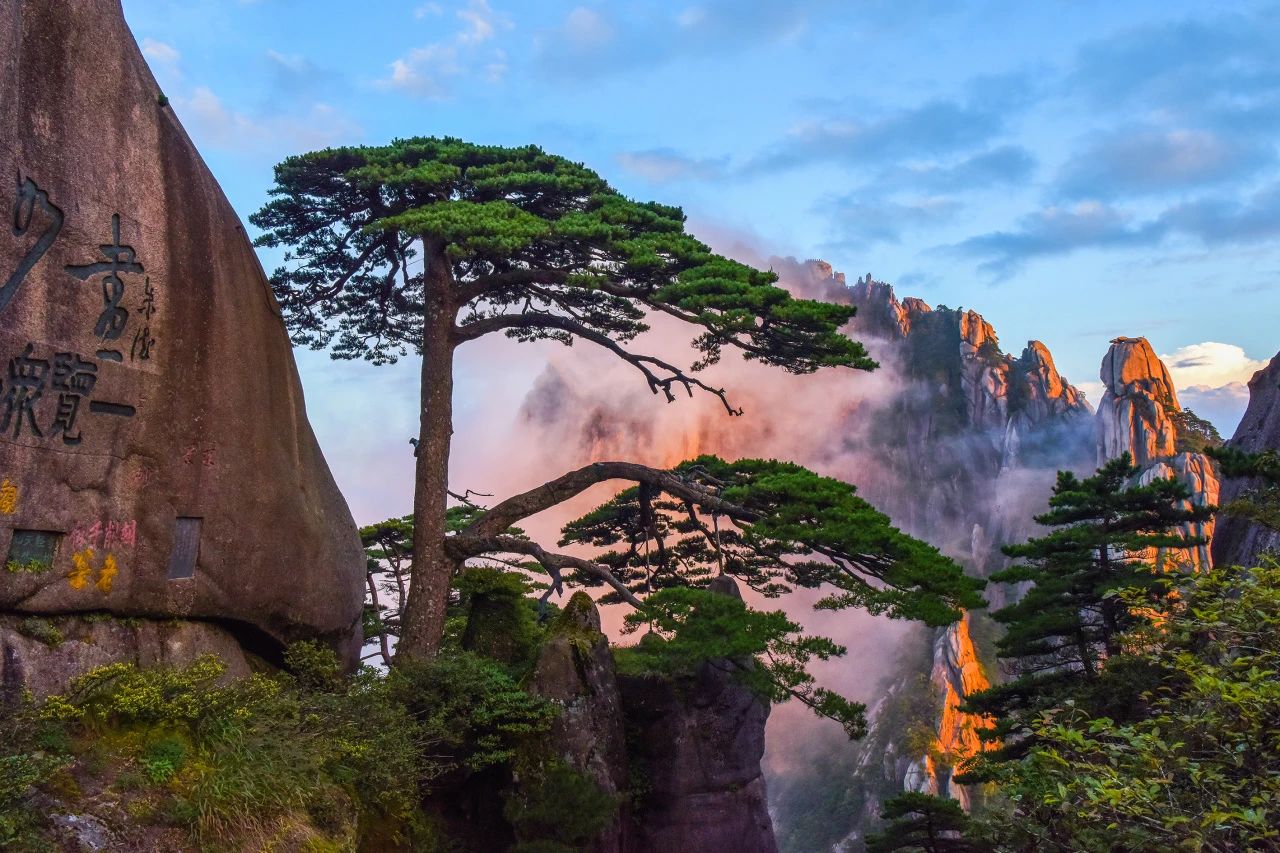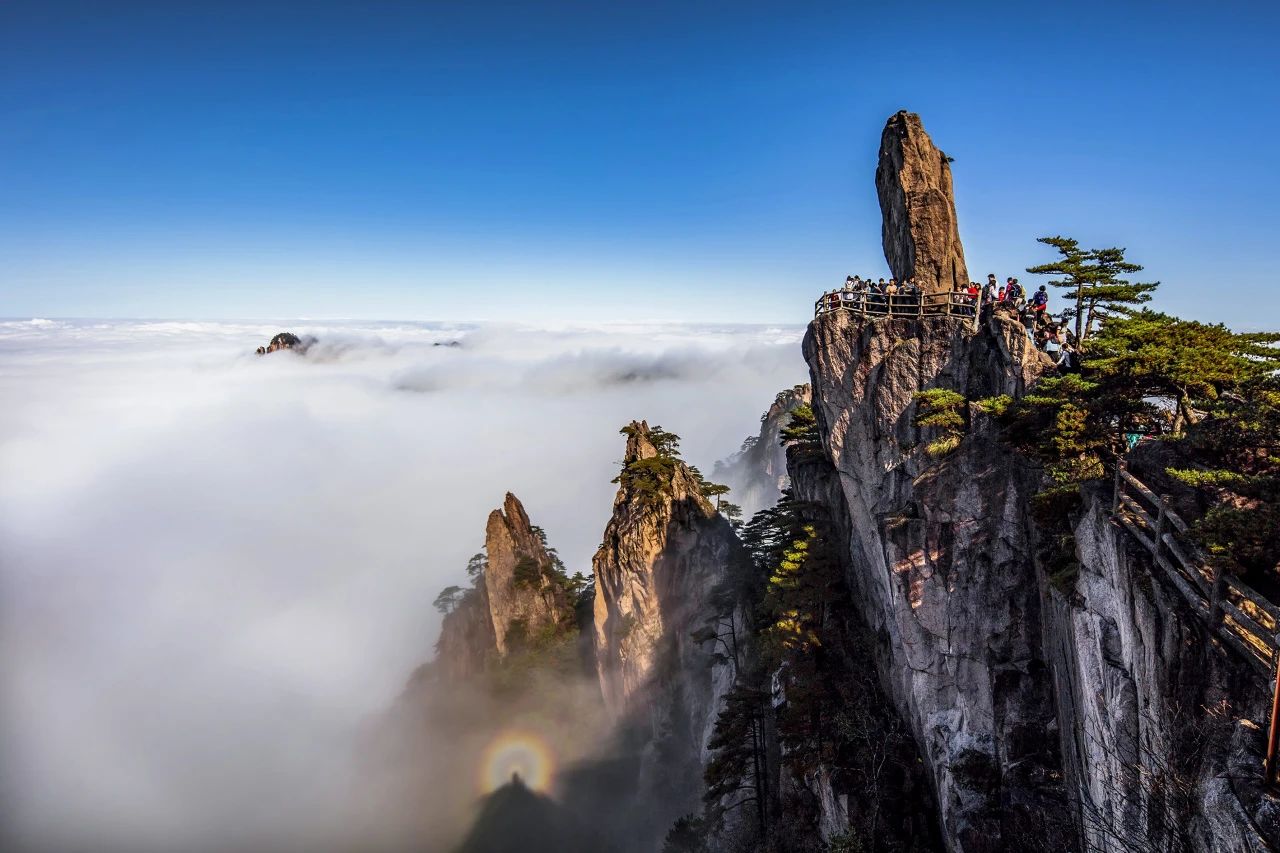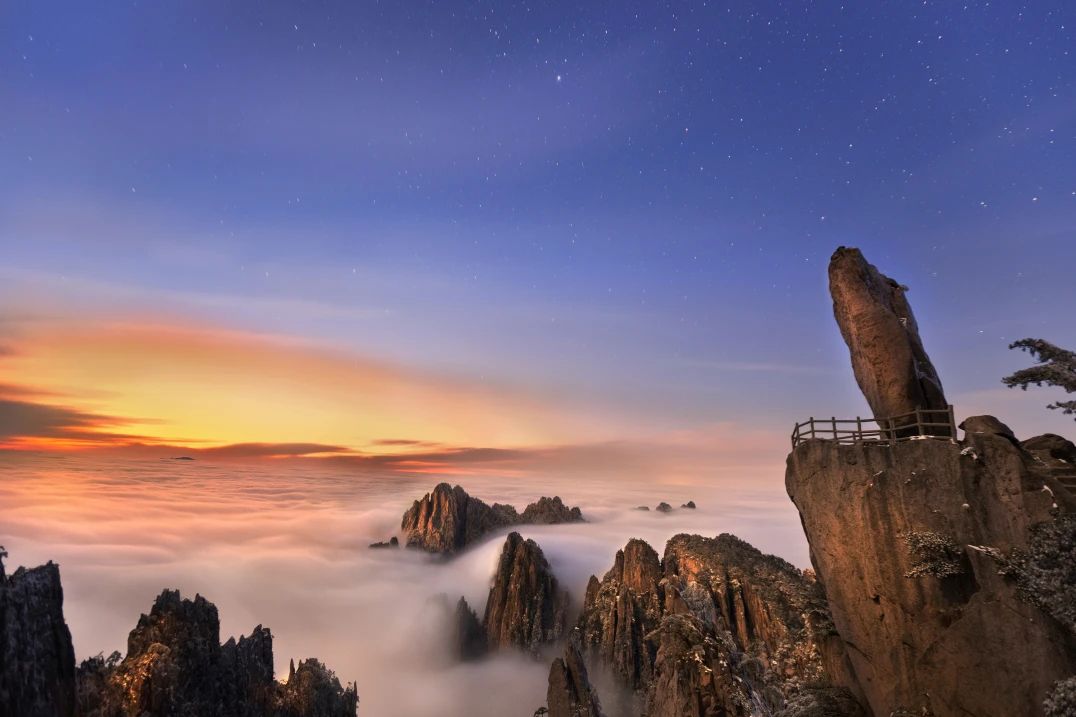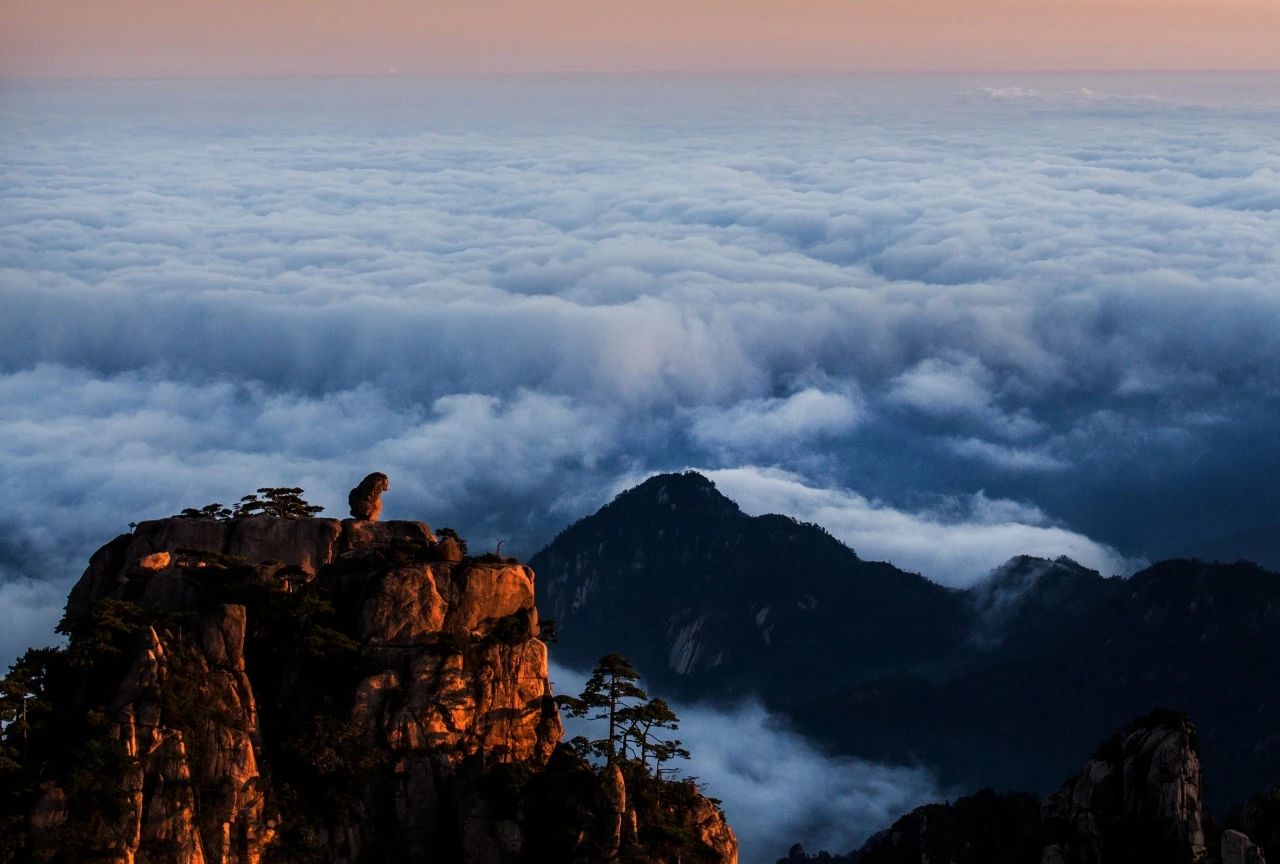GEOGRAPHICAL LOCATION: Huangshan District, Huangshan City
OVERVIEW: The Huangshan Scenic Area is located in Huangshan City, Anhui Province, covering an area of 160.6 square kilometers, with an outer protection area of 490 square kilometers. The highest peak, Lotus Peak, reaches an elevation of 1,864.8 meters. Historically known as Yishan, it earned its name due to its “verdant peaks resembling dark indigo from a distance.” According to legend, it is the resting place of the Yellow Emperor (Xuanyuan Huangdi). In 747, it was renamed Huangshan. The scenic area is renowned for its enchanting landscapes characterized by unique pine trees, strange rock formations, sea of clouds, hot springs, and winter snow, earning it the title of “the most extraordinary mountain in the Middle Kingdom.”
- WELCOME PINE

Welcome Pine
This ancient pine tree, over a thousand years old, is not only a landmark of Huangshan but also a symbol of Anhui tourism and a cultural icon representing China’s international exchanges. The personified Welcome Pine embodies qualities of resilience, strength, openness, and harmony, reflecting the spirit of the people of Huangshan in the new era.
This national protected tree stands beside the Qing Lion Rock and above the Manjushri Cave, measuring 10.15 meters in height, 2.05 meters in girth, and averaging 12 meters in crown spread. It has been included in the World Heritage List (1990), recognized as the first “living cultural relic” of the Huangshan pine species (2010), and crowned as “China’s Most Beautiful Tree King” (2017). The Chinese have a deep affection for the Welcome Pine, with poets and scholars praising it throughout the ages. At the opening ceremony of the Beijing Winter Olympics, the “Welcome Pine Fireworks” captivated the world, showcasing “Chinese-style romance” across major media outlets.
In 1959, a giant iron painting of “Welcome Pine” entered the Great Hall of the People in Beijing as a representation of Anhui’s traditional craftsmanship. Since then, the image of the “sturdy and courteous” Welcome Pine has often appeared in the international arena through foreign affairs hosted by national leaders. In 2018, Premier Li Keqiang gifted a Chinese landscape painting of “Huangshan Welcome Pine” to the ASEAN Secretariat, stating that it symbolizes the open and inclusive spirit of the Chinese people. He expressed the intention to show that China will continue to embrace openness and welcome guests from around the world to participate in China’s modernization process, sharing diverse civilizations with all peoples.
Since 1981, the Huangshan Scenic Area has assigned dedicated personnel for round-the-clock special care of the Welcome Pine, coining the term “Guardians of the Pine.” On August 13, 2022, General Secretary Xi Jinping wrote to Huangshan sanitation worker Li Peisheng and pine guardian Hu Xiaochun, acknowledging their efforts in preserving the ancient Welcome Pine and maintaining the beautiful Huangshan. He emphasized that “the most valuable aspect of ‘good people in China’ is their extraordinary achievements in ordinary work,” urging them to continue being role models and spreading positivity, thereby contributing to the great rejuvenation of the Chinese nation.
- FLYING ROCK

“Flying Rock”

“Flying Rock”
At the western end of the Heavenly Sea lies a massive stone, nearly rectangular in shape, standing on a base rock platform. It is approximately 7 meters wide, 1.5-2.5 meters thick, and 15 meters high, weighing about 544 tons. This giant rock has a small contact area with the underlying bedrock, as if it fell from the sky, hence the name “Flying Rock.” The rock is inscribed with the words “Picture Realm,” signifying deep meaning. The poet Cheng Yuheng from the Ming Dynasty wrote, “With my staff, I wander to this peak, fearing to ascend the highest point. Knowing you are from the sky, I fear you might fly away again.” Due to varying viewing distances and angles, the Flying Rock has multiple names, including “Thin Knife Peak” and “Smooth Sailing” as it appears to sail through the sea of clouds. Viewed from the north and northeast, it resembles a giant peach, also known as “Peach Rock” or “Peach Peak.” From the east, it appears like an old monk draped in a robe, gazing down at the West Sea Grand Canyon, hence the name “Old Monk Watching the Sea.” According to the “Huangshan Gazette” published in the 18th year of the Kangxi era (1679), there are three Flying Rocks in Huangshan, with two others located at the west side of Cuiwei Peak and in front of the small peak at Guyinglin Temple.
As Huangshan’s most famous rock, Flying Rock has garnered high praise from visitors throughout history. In 1986, it was chosen as the opening image for the classic TV series “Dream of the Red Chamber.” Legend has it that this rock was left over from Nüwa’s restoration of the sky, later falling to form this marvel. In reality, “Flying Rock” and its base were originally part of a single structure, composed of medium-grained porphyritic granite. The granite’s structural joints were developed due to the intersection of two nearly vertical sets of joints and one horizontal set, forming the initial shape of “Flying Rock.” Over time, with continued uplift of the mountain, weathering, glacial runoff, and gravitational collapse, surrounding rocks gradually eroded away, leaving behind the spectacular “Flying Rock” that now stands alone on its elevated platform.
- MONKEY WATCHING THE SEA

“Monkey Watching the Sea”
From the north side of Lion Peak’s Cool Breeze Platform, one can see a stone resembling a monkey perched on a peak, quietly observing the rolling sea of clouds, hence the name Monkey Watching the Sea. After the clouds dissipate, it resembles a distant view of the peaceful Huangshan District, earning it the alternate name “Monkey Gazing at Peace.” The “Stone Monkey” is about 3 meters tall and 1.5 meters wide, formed by two sets of vertical joints through erosion. Its head and jaw exhibit distinctive spherical weathering marks.
- SCATTERED FLOWER COVE
Located between the First Belief Peak and Lion Peak in the North Sea area, Scattered Flower Cove is surrounded by peaks resembling city walls, filled with unique pines and strange rocks, including the famous “Dream Pen Blossoms.” Scattered Flower Cove was named by Huang Ruxiang, a Jinshi from the Ming Dynasty, during his visit to Huangshan in 1610. The poet Cheng Zhiwen from the Qing Dynasty wrote, “Where do the celestial maidens scatter flowers? They come from the home of the Heavenly Emperor. A cove of floral fragrance divides the seasons, each competing to tell of autumn’s fruits and spring’s blossoms.” A viewing platform has now been built in front of the cove.